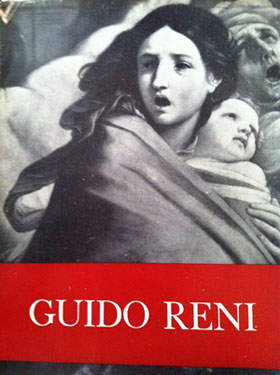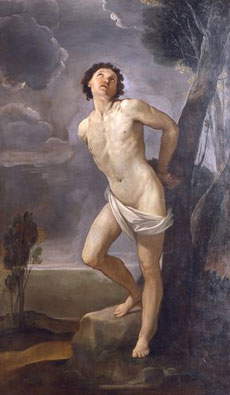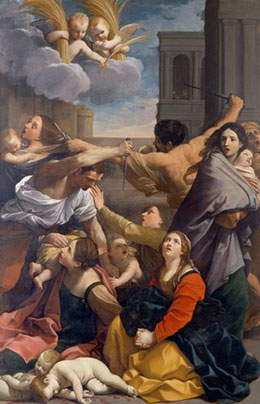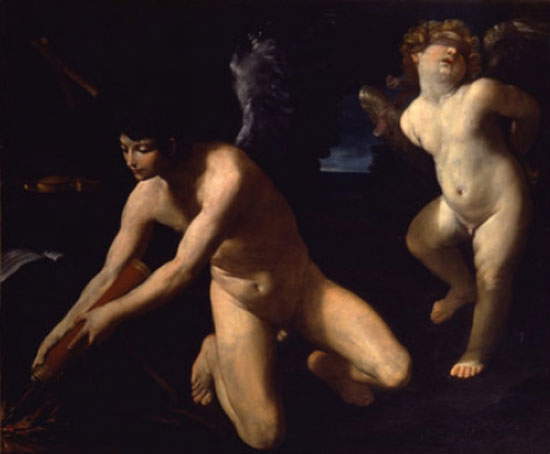Exhibitions in Bologna: Cesare Gnudi's Guido Reni (1954)
After curating the Exhibition of Bolognese Painting of the Fourteenth Century, which we had talked about in the first installment of this series of ours dedicated to the great Bolognese exhibitions of the past, Roberto Longhi moved to Milan where, in 1951, he curated the Exhibition of Caravaggio and the Caravaggesque painters, in the rooms of the Palazzo Reale. The exhibition was not only one of the most interesting ever on the level of scientific research, organization and layout, so much so that it is still a cornerstone to look to for many curators today, but it was also an incredible success with the public: more than 400,000 visitors in not even three months after its opening.
 |
| Catalog of the 1954 Guido Reni exhibition, edited by Gian Carlo Cavalli, with introductory essay by Cesare Gnudi |
Longhi’s Milan experience had, in fact, given an important signal: that is, it was possible to organize high-level exhibitions while also involving a sizeable audience. And this was also because, as was said of the exhibition of the Bolognese Trecento, the Italians of the 1950s manifested a high interest in art, to which contributed the desire to leave the war behind and to find in art a common cultural identity for the whole nation. The intuition of combining scientific rigor and palatability for the public led another great scholar active in the Bologna of the 1950s, Cesare Gnudi, to conceive the Biennali di Arte Antica: a series of exhibitions that, at two-year intervals, were to explore traditional artists. The exhibition with which the cycle opened was Guido Reni, from 1954, curated by Cesare Gnudi himself. It was held in the rooms of the Palazzo dell’Archiginnasio.
Why was it decided to start with Guido Reni, a painter whose fortunes at the time had all but fallen out of favor? Precisely in order to rehabilitate his fame: Guido Reni was among the greatest exponents of seventeenth-century Bolognese classicism, he was considered by his contemporaries as a “new Raphael,” he had a vast influence on the painters of subsequent generations, and for at least a century artistic tastes, especially those of the powerful, were dictated precisely by Reni’s art. Then, as we know, tastes change with the passage of time: today, for example, if we think of the seventeenth century, it comes naturally to us to think of Caravaggio as the highest expression of his time, but for his contemporaries (or at least those who followed the “official” taste of the time) the model of reference was Guido Reni. The nineteenth century and Romanticism overturned trends and judgments: the lack of dramatic force in his works (unthinkable for a painter inclined to idealization like Guido Reni) was seen, in a century that loved epics, pathos and strong feelings, as a flaw. For the Romantics, in short, Guido Reni’s paintings lacked substance, they were considered stereotypical religious paintings, his ethereal figures were considered affected and prissy, and above all not sincere in that Guido Reni’s art was seen as nothing more than an expression of Counter-Reformation coercions. Suffice it to say that in 1844, when the National Gallery in London purchased Guido’s Susanna and the Old Men, one of the most influential critics of the time, John Ruskin, described the painting as a work devoid alike of art and decency, “lacking both art and decency.”
 |
| Guido Reni, Saint Sebastian (1639-40; Bologna, Pinacoteca Nazionale) |
Critics’ opinion of Guido Reni remained unchanged for at least a hundred years. In Bologna people began to rediscover the painter in the years around World War II. But in the postwar period the nineteenth-century preconception still weighed on him: one of the main objectives of Cesare Gnudi’s exhibition was to put Guido Reni back in his rightful place, that of an influential and original leader of the school, capable of dictating tastes, fashions and trends for a very long time. The exhibition succeeded in hitting the mark in that it awakened an interest in Guido Reni that allowed the artist to be considered once again among the greats of art history-a judgment that has remained unchanged to this day and is probably destined to be the definitive one.
The exhibition was also fundamental in identifying with certainty the idea of beauty according to Guido Reni: an essential prerequisite for understanding the whole seventeenth- and eighteenth-century classicism that had in Guido Reni the main point of reference. For Gnudi, Guido Reni’s art is played on contrast. Or rather, on an “antinomy,” to use the scholar’s words: “that between the classical ideal, as a myth of beauty, and the ideal, the Christian inspiration,” as he wrote in the exhibition catalog. This “intimate, almost secret and unconfessed disagreement” is for Gnudi “one of the circulating motifs” in Guido Reni’s poetics. And it is from this contrast that his ideal of beauty takes shape, which seems to identify itself “as well as with the harmony of classical and Renaissance forms, with the very images of classical myth,” mediated, however, “with the reality in which he lived, in which he worked, in which he also believed: with the historical, political and religious reality of the Counter-Reformation.” Gnudi continues, “between his ideal of beauty and his religious feeling already settled in a quiet and accommodating piety, he perhaps never felt a real contrast. But between his great classical subjects and his randi sacred altarpieces, if there is no contrast of worlds confronting each other, neither can it be said that there is absolute identity of inspiration, to which the subject, the mythological or devotional motif is entirely indifferent.”
 |
| Guido Reni, Strage degli Innocenti (1611; Bologna, Pinacoteca Nazionale) |
Guido Reni managed to make these two souls, the classical and the Christian, coexist harmoniously, and without one prevailing over the other. Take, for example, one of the works on display, the Saint Sebastian from the Pinacoteca Nazionale in Bologna, a painting that, moreover, was restored for the occasion (in fact, exhibitions often give a way to work on paintings in need of intervention): the saint, who undergoes martyrdom strong in his faith, as evidenced by his upward gaze and the grimace that highlights a pain that seeks comfort, however, precisely in faith, assumes a pose of a classical statue, making clear the painter’s interest in ancient statuary, which Guido had the opportunity to study during his stay in Rome. And always this coexistence between the two souls led Guido Reni to give his classical subjects, especially in the last phase of his career, an almost metaphysical and transcendent aura: this is the case, for example, with the Cleopatra of Palazzo Pitti, painted around 1640 and also featured in the exhibition. The queen of Egypt, who usually inspired painters with scenes dense with eroticism, is devoid of sensuality in Guido Reni: only her breasts shown to the viewer refer to her femininity. Gnudi spoke of “restrained sensuality,” a restrained, but nevertheless not entirely dormant, sensuality that exhausts the feelings of the characters, “corrodes their classical dominated fullness and folds them into that sedate melancholy, far from the great passions, which over everything spreads its thin and uniform veil, its calm and bland reflection.”
The exhibition displayed the best of Guido Reni’s production: about seventy works, from Samson the Victorious and the Massacre of the Innocents in the Pinacoteca Nazionale in Bologna via the Penitent Magdalene in Palazzo Barberini, Amorsacro e amor profano in Pisa and Bacchus as a Child in Palazzo Pitti, to the production of the last phase of the artist’s career. Gnudi’s intuitions turned out to be fortunate: not only did the exhibition revitalize Guido Reni and place him in an international spotlight that was hitherto unknown to him (Bologna began to become one of the world capitals of art history in those very years), but it was also a considerable success with the public. Andrea Emiliani recalls that the exhibition managed to be visited by 80,000 visitors, and also sold 10,000 catalogs. There could not have been a better debut for the Biennials of Ancient Art.
 |
| Guido Reni, Amor sacro e amor profano (circa 1623; Pisa, Museo Nazionale di Palazzo Reale) |
Warning: the translation into English of the original Italian article was created using automatic tools. We undertake to review all articles, but we do not guarantee the total absence of inaccuracies in the translation due to the program. You can find the original by clicking on the ITA button. If you find any mistake,please contact us.





























